FAQs on Corydoras Cats:
Identification
Related Articles: Callichthyid Catfishes, Summer loving: cats in the garden, kittens in
the kitchen by Neale Monks,
FAQs on: Corydoras Catfish 1,
FAQs on: Corydoras
Catfish Behavior, Corydoras Catfish
Compatibility, Corydoras Catfish
Stocking/Selection, Corydoras Catfish
Systems, Corydoras Catfish
Feeding, Corydoras Catfish Health,
Corydoras Catfish Reproduction,
FAQs on: Panda
Corydoras, Pygmy Corydoras spp.,
FAQs on: Callichthyids
1, Callichthyids 2,
FAQs on: Callichthyid
Identification, Callichthyid
Behavior, Callichthyid
Compatibility, Callichthyid
Selection, Callichthyid
Systems, Callichthyid
Feeding, Callichthyid
Disease, Callichthyid
Reproduction, Catfish: Identification, Behavior, Compatibility, Selection, Systems, Feeding, Disease, Reproduction,
|
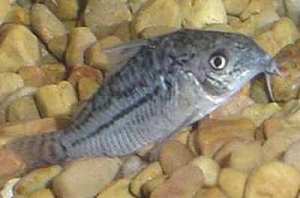
|
|
I.D. Corydoras catfish 11/4/18
Hi, I hope you could help with an id on a Corydoras I picked up recently.
<Will try.>
The closest I could find was C. copei.
<Corydoras copei is rare in the hobby. Though I agree, it certainly looks
similar in terms of markings. With that said, many species in this genus are
notoriously difficult to positively identify. Books have been written on the
subject (such as Fullers & Evers 'Identifying Corydoradinae Catfish') and
several names in the trade are almost certainly used for the wrong fish (most if
not all "Corydoras julii" are probably Corydoras trilineatus, for example). By
the same token, Corydoras copei is quite similar to a number of other species,
including Corydoras punctatus.>
Apart from the black in the dorsal the most distinctive feature is the black
line which runs down from the eye but there is also an electric blue line that
runs along side it. Also there is a black spot that appears on
the body just before the caudal peduncle, it comes and goes depending on mood.
<This latter feature is characteristic of Corydoras punctatus, but also appears
on Corydoras copei, Corydoras acutus, and a few others.>
Regards
Steve
<I do think your guess is a good one, but would suggest positing somewhere like
the PlanetCatfish forum where an expert on the genus might be able to help. In
the meantime, rest assured that this species has all the same requirements as
the vast majority of Corydoras; to wit, low-end tropical temperature (22-25
C/72-77 F) water that isn't too hard (1-15 degrees dH, pH 6.0-7.5) and not too
deep (ideally 30 cm/12 inches at most). Keep in groups, on a soft, ideally sandy
substrate, and provide brisk but not turbulent water current. Avoid nippy
tankmates, but otherwise mixes well with community fish. Cheers, Neale.>
|
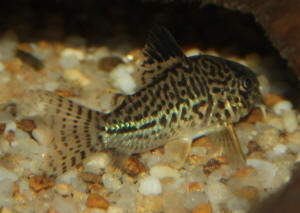 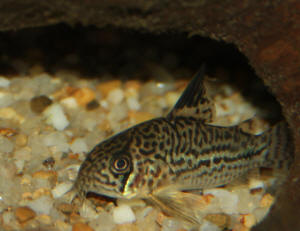 |
|
Identifying a Corydoras 3/30/18
Hey there guys,
I'm just trying to get a clear determination what type of Corydoras this is in
the photos.
Can you identify for me?
Thanks for your help.
Dave
<Hello Dave. This is almost certainly a Corydoras paleatus, albeit somewhat
quirky, one might say, in development. Whether this a genetic, diet or some
other issue isn't easy to say. There are (tank-bred) long-finned Corydoras
paleatus in the trade, and it looks like this has at least a bit of those genes
in it. Nonetheless, I'd suggest running this past the nice folks at
PlanetCatfish.com, who are very good at identifying oddball catfish. There are
some Corydoras paleatus lookalike species out there, and while they're expensive
and rarely traded, if you buy rehomed fish from a local pet store, sometimes you
get lucky, the retailer had no idea what they were, and you end up with these
special fish at a bargain price! Cheers, Neale.>
|
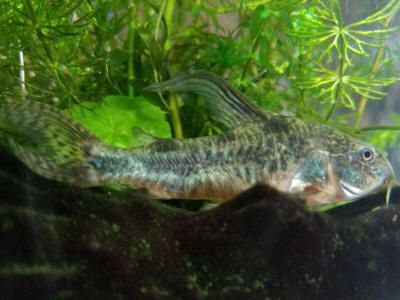 |
|
Re: identifying a Corydoras
3/31/18
Thanks, Neale.
<Welcome.>
I will do that.
<Cool.>
He was sold as a paleatus, but over time those patterns on his front end
made me think he was not a pure bred paleatus, and I couldn't find other
paleatus photos with such a pattern. It developed after several years.
<Indeed. There are lookalike species, such as Corydoras ehrhardti, but these
are rather rare in the trade. They do turn up, of course, but will be sold
at a premium price. Yours has, for example, a deformed dorsal fin spine that
suggests inbreeding, hence my belief that this is a Corydoras paleatus,
albeit one that's more reminiscent of one of the fancy varieties, like the
long-finned strain, than the true, wild-type.>
He eats New Life Spectrum Algae Max as he primary food, and Hikari algae
wafers and their generic bottom feeder product (orange packaging with cute
catfish displayed) occasionally...
<All sounds great. Algae wafers are a superb staple for these and most other
small catfish, including Suckermouth catfish and the smaller
Synodontis. Couple these with occasional offerings of other foods and you
can't go far wrong! Do try offering snippets from the kitchen though --
white fish fillet, shrimp, clams, cooked peas, even (very occasionally) hard
boiled egg yolk. The fish will enjoy the occasional treat like these, and
cooked peas especially help to avoid constipation. That said, New Life
and Hikari products are 100% complete, so if your fish are thriving, there's
no need to add stuff if you don't want to.>
Specchio is his name. Thanks - he is very special and I love him dearly.
<Glad to hear it! One thing I will mention about Corydoras paleatus is that
this is a low-end tropical species, and will be happier kept below 25 C/77
F, so if your other community fish allow it, feel free to dial back the
heater setting. 22 C/72 F is ideal, and also happens to be ideal for a lot
of other low-end tropicals including Zebra Danios, Platies, Neons, and
almost all other Corydoras catfish! Here in England I've kept them outdoors
in summer, and guess what, they bred immediately after being brought indoors
in the autumn!
http://www.wetwebmedia.com/fwsubwebindex/coryreproart.htm
These are tough, but often misunderstood little catfish. Cheers, Neale.>
Re: identifying a Corydoras 4/4/18
Neale, Thanks for all the valuable shared knowledge and observations on
Specchio!
<Most welcome.>
I will assume he is a Paleatus, and yes, he does have that adorable dorsal fin,
which is a bit unusual around here, at least. I never see others like him at
stores.
<Indeed!>
I've never tried offering while fish fillet, shrimp or clams, but will consider.
<Tiny, tiny bits of any sort of seafood are usually worth a shot with catfish,
or indeed most kinds of fish. Remove anything uneaten and ignored after a few
minutes.>
He doesn't like peas, I've learned. Any veggie suggestions I'll try, but
lettuce, peas or carrots were never successful.
<Oh; well, keep trying! Sometimes a bit of hunger sweetens the deal. Starve the
fish for a few days, then squish a cooked pea in the tank so the soft centre
falls apart. It's a high fibre food, and good for minimising the risk of
bloating and constipation.>
I never make eggs, as in Hawaii they are pricey, but again, good to know.
There's no heater on his tank; he lives in room temp in an air conditioned
apartment, about 74...
<Sounds ideal.>
Funny you keep them outside. I get health advise on caring for fish from a
freshwater aquatic disease specialist at the Waikiki Aquarium here in Honolulu
where I live, and he raises Synodontis Petricola in an outdoor pond here.
<I would imagine! Since you're practically the tropics, I'd assume many tropical
fish would thrive outdoors, assuming there's no risk of them escaping, of
course. In England, keeping tropicals outdoors is very much a
season thing, as you can imagine! But it does work well for the hardier species.
They get lots of natural foods to eat, algae and bugs and such, and that does
encourage breeding and good colouration.>
Thanks for the advice and details. Really appreciate it.
Aloha, Dave
<Aloha indeed, Neale.>
|
New Cory ID? 9/15/11
Hello Crew!
So I was at my LFS today, and I saw 4 Corydoras marked as C.
Sterbai. I am 100% sure, this is not the case.
<I agree.>
I thought they were C. napoinses, so I picked them up and now
that I have a better opportunity to look at them, I don't
think so. I'm thinking possibly C. elegans? Any other
suggestions or ideas would be appreciated.
<Do look like Corydoras haraldschultzi, but really, I'm
not an expert on these. Do you know the Planet Catfish site?
That's the place I'd go for help on these fish. On the
plus side, at least Corydoras are all pretty similar in terms of
care!>
Thanks! (attached two photos)
-Jesse
<Good luck, Neale.>
|
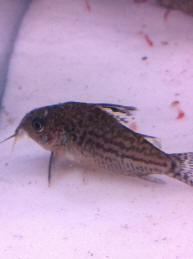 |
|
Corydoras ID -11/18/07 Lord, I hate to bother you all
again. But I've spent several days at planetcatfish.com
trying to ID this little Corydoras catfish and can't seem to
find what he/she is. I ordered Corydoras trilineatus and 2 of
these came in the same batch. I'm putting them all in the 125
gal with the Severum (after 4 wks quarantine). I'd like to
get a few more of this species because I noticed Corys seem to
hang out with their own species pretty often and I want them to
be comfortable. If you can ID him for me I'd certainly be
grateful and so would the little Cory. Thank you all, you're
the most wonderful group of volunteers I've ever encountered.
Mitzi <Hello Mitzi. Your catfish could well be Corydoras
trilineatus. As you perhaps realise, Corydoras trilineatus and
Corydoras julii are routinely mixed up. In fact many catfish
experts reckon that most of the fish sold as Corydoras julii are
actually Corydoras trilineatus. The give-away is the head:
Corydoras trilineatus has black worm-like markings on its head,
whereas Corydoras julii has discrete, approximately circular
spots. Because your fish doesn't seem to have those spots on
its head, I don't think it is Corydoras julii. I agree with
you that Corydoras are happiest in big groups. Six specimens
seems to be the minimum to really get the most from them. Kept
like that, they are less shy and more entertaining, as well as
easier to breed. Thanks for the kind words, and hope this helps.
Cheers, Neale.>
Corydoras ID/tank height -11/18/07 I have a PS to the
email below I just sent. I just read a quote from Neale at
wetwebmedia.com/FWSubWebIndex/callcatdisfaq2.htm saying
"<Circulation of the water is important. But also how
deep is the tank? Corydoras are obligate air breathers, and they
will literally drown in an aquarium too deep for them. For the
smaller species, around 30 cm is about right. Anything over 45 cm
is dodgy, in my opinion.>" This had occurred to me before
but now I'm extremely concerned. The 125 gal tank I planned
to put 12 Corydoras into is 22" tall (or 60 cm). Is that
going to be too tall for them?? If it is I'll just buy them a
40 gal long and put some Hatchet fish in with them. Just when I
think I'm done worrying I find out I'm not :-( I'd
love to hear your opinions. Mitzi <Hello Mitzi. In deep tanks,
small Corydoras may struggle to reach the surface. In a plain
aquarium, 45 cm may be taken as a safe depth of water for medium-
to large-sized species like Corydoras panda and Corydoras aeneus.
Smaller species, like Corydoras hastatus, shouldn't really be
kept at more than 30 cm depth. In deeper tanks, it's
generally recommended you go with Brochis rather than Corydoras
spp; Brochis are altogether stronger swimmers and naturally come
from relatively deep waters. Corydoras are very much shallow
water fish that inhabit creeks and streams rather than rivers. My
peppered Corydoras live in a tank where the water is about 40 cm
deep, and they seem fine. What I have noticed is they often rest
half-way on stiff plants such as Anubias. So, if your tank is
unusually deep, you might incorporate such resting places so that
their life isn't too difficult. Do note that I'm talking
about the depth of water rather than the depth of the tank; by
the time you allow for the depth of substrate and the air space
at the top of the tank, your 60 cm aquarium will likely only
contain around 50 cm of water depth. While still deeper than the
optimum, with a few robust plants, bogwood roots, or rocky
ledges, your catfish should be fine. Cheers, Neale.>
|
|

|
Platy - Gourami mix revisited: this time, +cats! 2/2/06 Hi
crew! Thanks for your quick+informative reply regarding my platies! The
little guys look very happy! I followed your advice and bought a test
kit: all very good readings: Ammonia: 0 Nitrate:0 Nitrite:25 - 50
<These last two are crossed-over... and nitrate's a bit high. Do
try to keep below 20 ppm... means covered on WWM> Ph: not sure, as
it was a funny light blue colour, but I'm guessing it was about
7.5, and they told me not to worry about it at my local fish store
place. <Is likely fine... also covered> I did not buy the
gouramis, as planned, but instead bought 2 little cats. I hope to get
the gouramis later. My question is about my cats. In the shop, they
were labeled as "speckled cats", but when I got them home and
looked in a fish book, there was a picture of them... Labeled as
peppered Corys! I can't send a pic. with this, but I'm working
on it! They seem very peaceful and fun loving, could they be the
peppered Corys? <Are very likely a species of Corydoras... maybe
paleatus... covered on WWM... fine here> Thanks for replying to my
email, and once again, thanks for your great site! <Welcome. Bob
Fenner>
|
|

